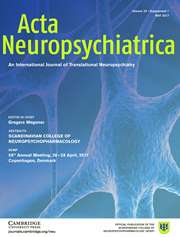No CrossRef data available.
Article contents
Escitalopram alters tryptophan metabolism, plasma lipopolysaccharide, and the inferred functional potential of the gut microbiome in deer mice showing compulsive-like rigidity
Published online by Cambridge University Press: 03 April 2025
Abstract
Compulsive-like rigidity may be associated with hyposerotonergia and increased kynurenine (KYN) pathway activity. Conversion of tryptophan (TRP) to kynurenine (KYN), which may contribute to hyposerotonergia, is bolstered by inflammation, and could be related to altered gut microbiota composition. Here, we studied these mechanisms in a naturalistic animal model of compulsive-like behavioural rigidity, i.e., large nest building (LNB) in deer mice (Peromyscus sp.).
Twenty-four (24) normal nest building (NNB)- and 24 LNB mice (both sexes) were chronically administered either escitalopram (a selective serotonin reuptake inhibitor; 50 mg/kg/day) or a control solution, with nesting behaviour analysed before and after intervention. After endpoint euthanising, frontal cortices and striata were analysed for TRP and its metabolites, plasma for microbiota derived lipopolysaccharide (LPS) and its binding protein (LBP), and stool samples for microbial DNA.
LNB, but not NNB, decreased after escitalopram exposure. At baseline, LNB associated with reduced frontal cortical TRP concentrations and hyposerotonergia that was unrelated to altered KYN pathway activity. In LNB mice, escitalopram significantly increased frontal-cortical and striatal TRP without altering serotonin concentrations. Treated LNB, compared to untreated LNB- and treated NNB mice, had significantly reduced plasma LPS as well as a microbiome showing a decreased inferred potential to synthesise short-chain fatty acids and degrade TRP.
These findings support the role of altered serotonergic mechanisms, inflammatory processes, and gut microbiome involvement in compulsive-like behavioural rigidity. Our results also highlight the importance of gut-brain crosstalk mechanisms at the level of TRP metabolism in the spontaneous development of such behaviour.
- Type
- Original Article
- Information
- Creative Commons
- This is an Open Access article, distributed under the terms of the Creative Commons Attribution licence (http://creativecommons.org/licenses/by/4.0/), which permits unrestricted re-use, distribution and reproduction, provided the original article is properly cited.
- Copyright
- © The Author(s), 2025. Published by Cambridge University Press on behalf of Scandinavian College of Neuropsychopharmacology


